Boxes / Desk
Browse our collection of antique silver Boxes, Miniature Items, Inkstands and Desk Related Objects
Small Silver and Gold Boxes, Vinaigrettes, Snuff Boxes, Tea Caddies, Biscuit Boxes, Cases, Cigar Boxes, Speciality Boxes etc.
Since antique times caskets have been used to keep important documents and jewels. In England silver boxes (and gold) in a various of shapes and sizes became popular in the seventeenth century. Small boxes, designed for many diverse uses – counters, snuff, vestas, tobacco, vinaigrettes, scent, nutmeg, toothpicks, toilet boxes. Larger boxes, made for specific storage requirements, including tea, sugar, biscuits, cigarettes and cigars. The jewellery box remains as popular today as it did in ancient times.
Miniature Boxes, Dishes, Toys, Models, Kitchenware and Musical Instruments
Silver toys originated in Europe during the 17th century and were made initially for the children of kings and queens. At that time England was still suffering under Puritanism and it wasn’t until the Restoration of Charles II in 1660 that silver toys were made available in this country. The earliest English silver toys date from 1665 and were made in London; it was uncommon for toys to be made in the provinces. The Dutch were the leading manufacturers of silver toys, their most prolific period being 1725-1750, and by then wealthy royalty, landowners and business men were buying toys for their own pleasure as well as that of their children’s.
The Traveller’s Sample would be an exact copy of a full size original. The great attention to detail and slightly larger size than normal toys of this period generally indicates this purpose.
Inkstands and Inkwells. Desk Accessories, Bells, Pens, Letter Openers, Seals
The inkstand did not enter into common household use until the 18th century. Earlier 17th century examples exist but are exceedingly rare. The main requirement was a container for ink and another for sand (or pounce) which was used for drying the ink. Also required was a space to put quills. Some inkstands also incorporated a taper stick for melting sealing wax or even a bell.
Desk accessories form a wide and interesting collecting field and they make an excellent gentleman’s gift. It’s thought that the first handwritten letter was written, probably on canvas, by a Persian queen in around 500BC. Letters were vital for basic communication, both personal and formal, and were governed by basic rules of etiquette. The equipment required to write a simple letter was quite extensive including paper, envelope, pen, ink, blotter, stamps. Once written the letter or scroll needed to be sealed using a candle wax kit. Letter openers are useful gifts.
Boxes / Desk
Browse our collection of antique silver Boxes, Miniature Items, Inkstands and Desk Related Objects
Small Silver and Gold Boxes, Vinaigrettes, Snuff Boxes, Tea Caddies, Biscuit Boxes, Cases, Cigar Boxes, Speciality Boxes etc.
Since antique times caskets have been used to keep important documents and jewels. In England silver boxes (and gold) in a various of shapes and sizes became popular in the seventeenth century. Small boxes, designed for many diverse uses – counters, snuff, vestas, tobacco, vinaigrettes, scent, nutmeg, toothpicks, toilet boxes. Larger boxes, made for specific storage requirements, including tea, sugar, biscuits, cigarettes and cigars. The jewellery box remains as popular today as it did in ancient times.
Miniature Boxes, Dishes, Toys, Models, Kitchenware and Musical Instruments
Silver toys originated in Europe during the 17th century and were made initially for the children of kings and queens. At that time England was still suffering under Puritanism and it wasn’t until the Restoration of Charles II in 1660 that silver toys were made available in this country. The earliest English silver toys date from 1665 and were made in London; it was uncommon for toys to be made in the provinces. The Dutch were the leading manufacturers of silver toys, their most prolific period being 1725-1750, and by then wealthy royalty, landowners and business men were buying toys for their own pleasure as well as that of their children’s.
The Traveller’s Sample would be an exact copy of a full size original. The great attention to detail and slightly larger size than normal toys of this period generally indicates this purpose.
Inkstands and Inkwells. Desk Accessories, Bells, Pens, Letter Openers, Seals
The inkstand did not enter into common household use until the 18th century. Earlier 17th century examples exist but are exceedingly rare. The main requirement was a container for ink and another for sand (or pounce) which was used for drying the ink. Also required was a space to put quills. Some inkstands also incorporated a taper stick for melting sealing wax or even a bell.
Desk accessories form a wide and interesting collecting field and they make an excellent gentleman’s gift. It’s thought that the first handwritten letter was written, probably on canvas, by a Persian queen in around 500BC. Letters were vital for basic communication, both personal and formal, and were governed by basic rules of etiquette. The equipment required to write a simple letter was quite extensive including paper, envelope, pen, ink, blotter, stamps. Once written the letter or scroll needed to be sealed using a candle wax kit. Letter openers are useful gifts.
-

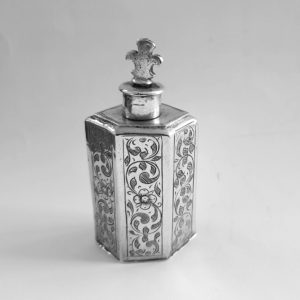
Circa 1580
10187 Elizabeth I Antique Silver Bottle
Sold
A fantastic little collector’s item. A rare 16th century silver bottle, tiny size, probably for perfume oil or holy water. The detachable screw top contains a space inside for either a cork or dip stick. The body is finely engraved with hatched ornament typical of the mid to late 16th century. Weight 20 grams. Height 6.5cm (to the top), 4.3cm (to top of body). Base measures 3.2cm x 2.2cm. English. Circa 1580. Unmarked silver.
-

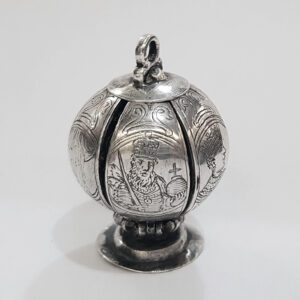
Circa 1600 - 1620
10349 17th Century Antique Silver Pomander
Sold
An intriguing piece of history contained in a small silver sphere. The antique silver pomander was worn round the neck or suspended from a belt and was intended to protect the wearer from sickness. The exterior of this example is hand engraved with royal portraits, probably English, based on engravings by Simon de Passe (c. 1595 – 6 May 1647). The screw top unturns to release six hollow, hinged segments to contain dried flowers, spices and scented oils. The interior is decorated with scroll and hatched engraving. A similar example formed part of the prestigious David Little collection. Weight 22 grams, less than 1 troy ounce. Height 3.9cm. Spread 5.6cm fully extended. Unmarked silver. Probably English. Circa 1600-20.
-

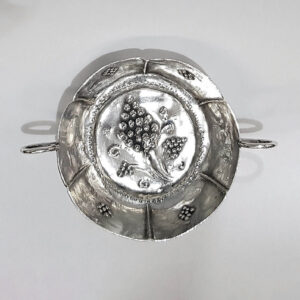
Circa 1670
10393 Charles II Antique Silver Miniature Wine Taster
£1,250
A charming little early English miniature dish from the reign of Charles II. Very sweet size. This little cup has a circular form with simple wirework handles and an embossed grape decoration. Owner’s initials “AA” engraved to the top rim. Weight 12 grams, less than half a troy ounce. Height 1.5 cm approx. Diameter of top 5.2cm. Spread across handles 7.4cm. English, circa 1670. Unmarked sterling silver.
-

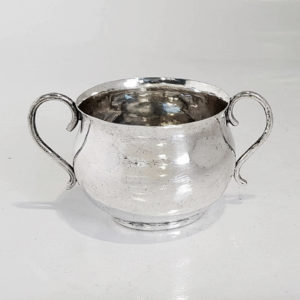
1673
8394 Charles II Silver Porringer
£1,750
A rare early English silver porringer of small size having 2 side handles and belly shape. Lovely original hand beaten finish. Weight 69 grams, 2.2 troy ounces. Height 5.5 cms. Diameter 6 cms. London 1673. Maker IC* listed in Jacksons.
-

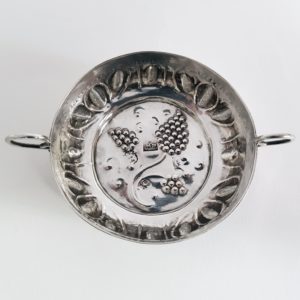
1673
George Watkins
10182 Charles II Antique Silver Wine Taster
£2,750
A rare early English miniature wine taster from the reign of Charles II. Very charming size. This little cup has a circular form with simple wirework handles and embossed grape decoration. Weight 21 grams, less than 1 troy ounce. Height 2 cm approx. Diameter of top 6.1cm. Spread across handles 8.9cm. London 1673. Made by George Watkins. Sterling silver.
-

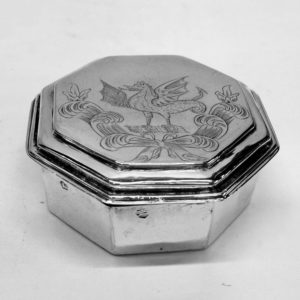
1675
Isaac Dighton
9172 Antique Charles II Silver Boxes
£6,950
A very rare matching pair of early antique silver boxes of octagonal form, with pull off tops, dating from the reign of King Charles II. Sterling silver. Simple plain form with a large hand engraved crest within tied plumage, very typical of the date. Superb antique colour. At this date boxes of this type would have originally been part of an extensive toilet service. Total weight 239 grams, 7.6 troy ounces. Height 3.5 cm. Width of top 9 cm. London 1675. Maker Isaac Dighton, London.
-

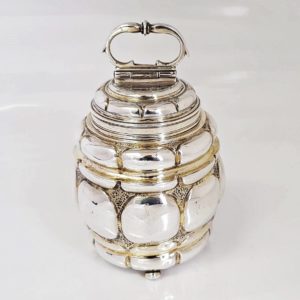
1675 - 1679
Marx Schaller
9789 Antique German Silver Tea Cannister
£6,500
A 17th century German parcel-gilt silver caddy of barrel shape. With a screw top lid and drop ring handle. Beautifully made and very tactile to hold. Suitable for tea and sugar. Raised on four ball feet, the box is decorated throughout with silver lobes against a matted gilt background. Weight 321 grams, 10.3 troy ounces. Height 11.5cm (to the top), 15cm (to top of handle). Stamped on the top and underside of body with German silver marks and assay scrape for Augsburg, Germany. Maker Marx Schaller II. Circa 1675-79. See Rosenburg German silver marks for Augsburg page 127.
-

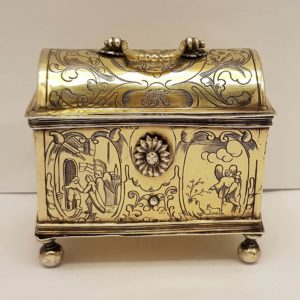
Circa 1680
9568 Antique Dutch Silver Marriage Box
£9,500
A 17th century silver gilt casket of traditional rectangular form. The domed top with swing handle is hand engraved with a bridal couple surrounded by birds and foliage. The body, standing on four ball feet, has a front locking catch in the form of a flower, and is hand engraved with old testament scenes. Initials to the front of the lid. Weight 162 grams, 5.2 troy ounces. Height 7.7cm. Length 8.5cm. Depth 5cm. Stamped underneath twice with a maker’s mark (anvil?) unidentified. Circa 1680.
-

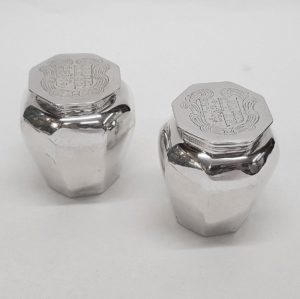
Circa 1690
Anthony Nelme
9371 17th Century Antique Silver Boxes
£3,750
A pair of early English antique silver toilet jars with lift off lids. Plain octagonal form. The tops have a hand engraved armorial within plumage feathers, typical of the Charles II/James II period. These unusual miniature toilet jars are very charming. Superb antique colour. At this date boxes of this type would have originally been part of an extensive toilet service. Total weight 148 grams, 4.7 troy ounces. Height 6cm. Diameter of lid 3.8cm. Makers mark only for Anthony Nelme. Circa 1690. Sterling silver.
-

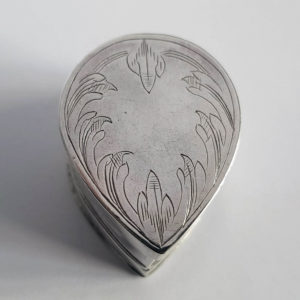
1690
9997 William & Mary Antique Silver Nutmeg Grater
Sold
A charming little late 17th century silver nutmeg grater of teardrop form, one side fitted with a serrated rasp. Each side has a hinged lid with stand-away hinge. Both covers are hand engraved with simple foliate decoration. Weight 29 grams, 0.9 troy ounce. Height 2.5 cm. Top 3.7 x 2.9 cm. Total spread across the covers 8.3cm. Unmarked silver. English. Circa 1690.
-

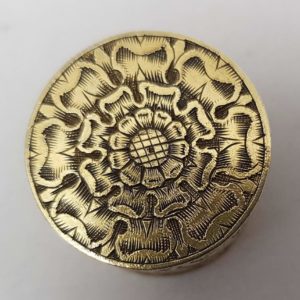
Circa 1690
10212 17th century Antique Silver Counter Box
£1,750
An antique silver counter box of typical cylindrical form. The hand engraved decoration is very unusual having a finely worked matted and hatched background. The pull-off cover is decorated with the Tudor rose, the sides with cherubs, fruit and foliage. Weight approx.10 grams, 0.4 troy ounces. Diameter 2.1cm. Height 1.8cm. Probably English. Circa 1690. Unmarked silver. 17th century.
Literature. Counter boxes contained a number of disks, commonly stamped or engraved with portraits of English monarchs, that were used as game markers and counting devices. Counter boxes were rarely marked.
-

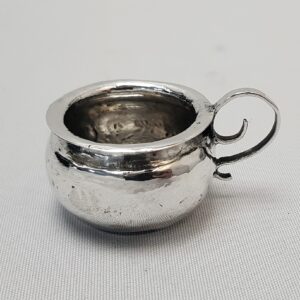
Circa 1690
Charles Eystone
10394 William & Mary Antique Silver Miniature Chamber Pot
Sold
A charming little doll’s house piece. This rare miniature antique silver potty is made of hand beaten sheet silver with a simple scrolled handle. It dates to the second half of the 1600’s. Weight 13g, less than half a troy oz. Spread 4.9cm. Diameter 3.4cm. Height 2.5cm (to top of handle). London, circa 1690. Maker Charles Eystone. Sterling silver.
-

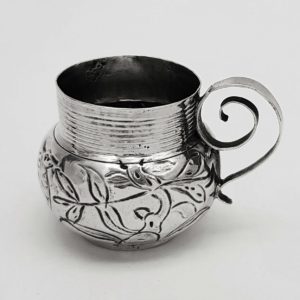
1693
George Manjoy
9539 William & Mary Antique Silver Miniature Mug
£2,350
A delightful little collector’s piece. This rare miniature (or toy) mug is an exact copy of a full size original. Of globular form it has a reeded and incised neck, and double scroll handle. This style was only made for a short period at the end of the 17th century and is the earliest type of mug you are likely to come across. The body is engraved with an exotic bird and leafy branches. Weight 14 grams, less than 1/2 troy ounce. Height 3.5cm. Spread 4.9cm. London 1693. Maker George Manjoy, a specialist toy maker.
-

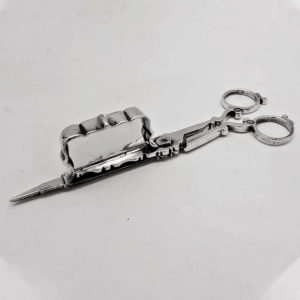
1701
Thomas Brydon
10371 William III Silver Snuffer Scissors
Sold
A rare early English silver candle douter, also called a wick trimmer, with the simple plain style typical of the period. *Britannia standard silver. Weight 94 grams, 3 troy ounces. Length 15.9cm. Width 5.5cm. London 1701. Few snuffers were made prior to 1700. Maker Thomas Brydon, see Jackson’s Silver & Gold Marks page 154, a known snuffers and stand maker.
-

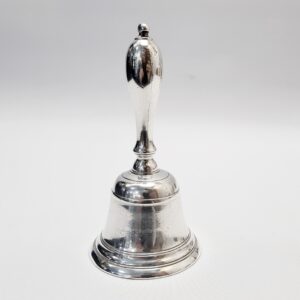
1701 - 1720
David Greene
10384 George I Antique Silver Bell
Sold
A rare early English silver hand bell from the early 1700’s. Lovely plain style with concentric bands around the centre and bottom rim. Heavy cast silver. Weight 207g, 6.6 troy oz. Height 13.3cm. Diameter 6.7cm. Owner’s initials “MP” engraved to the top of the handle. London circa 1701-1720. Maker David Green. Britannia Standard silver, 95.8% purity.
-

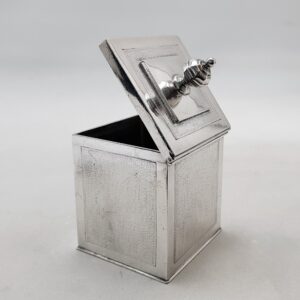
1704
Thomas Parr
10352 Queen Anne Antique Silver Tea Caddy
Sold
An extremely rare collector’s item dating to the early 1700’s. This unique little silver tea box of cube form has a hinged lid with octagonal finial. The hand applied matted work is very specific to the 1680-90 period. The small size is due to the rarity of tea at this early date. Weight 203g, 6.5 troy oz. Height 9cm (finial), 7cm. Top measures 6.3cm square. London 1704. Maker Thomas Parr I. Britannia standard silver.
-

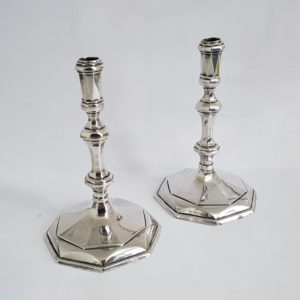
1712
Joseph Bird
10232 Queen Anne Antique Silver Tapersticks
£5,850
A rare pair of dainty little antique silver tapersticks with the desirable octagonal shape. Superb quality. Lovely crisp finish. The straight lined form features a faceted sconce and foot and a plain knopped tapering stem. Total weight 200 grams, 6.4 troy ounces. Height 12cm. Base diameter 7.1cm. London 1712. Maker Joseph Bird. Britannia standard silver. 18th century.
-

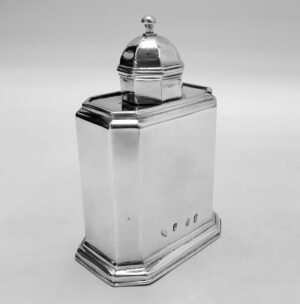
1718
John Farnell
10303 George I Antique Silver Tea Caddy
Sold
A good early English silver caddy of plain rectangular design with the plain hexagonal design typical of the early 1700’s. The sliding top has a lift off cap which doubles as a tea measure. Weight 226 grams, 7.2 troy ounces. Height 12.6cm. Base 8.9 x 5.8cm. London 1718. Maker John Farnell. Britannia standard silver – purity 95.8%*. 18th century.
-

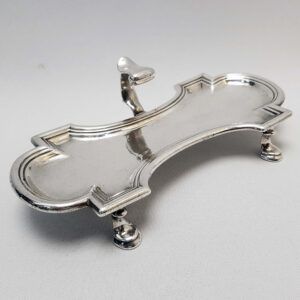
1718
Paul de Lamerie
10396 George I Antique Silver Snuffer Tray
£7,750
An antique silver snuffer stand, a good early example by the celebrated Huguenot maker Paul de Lamerie. Of shaped rectangular form with curved sides and a central carrying handle. Good plain design and heavy gauge silver typical of this date. Weight 267g, 8.5 troy oz. Height 2.7cm/5.6cm (top of handle). Length 18.4cm. Width 8.3cm. London 1718. Maker Paul de Lamerie. Britannia standard silver, 95.8% purity.
-

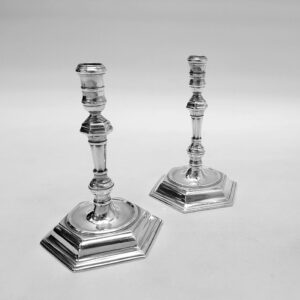
1724
John Bache
10302 George I Antique Silver Tapersticks
£3,350
A delightful pair of little antique silver taper sticks with the plain hexagonal design typical of the early 1700’s. Cast silver. Total weight 235 grams, 7.5 troy ounces. Height 11.4cm. Base measures 7 x 8cm. London 1724. Maker John Bache. Britannia standard silver – 95.8% purity*. 18th century.
-

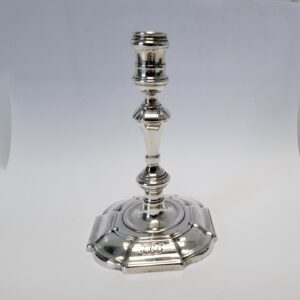
1725
John Eckford
10366 George II Antique Silver Taperstick
£895
A pretty little antique silver taperstick with knopped stem and shaped rectangular base. Nice plain style. Hand engraved initials “ERB” in old fashioned script to the foot. Cast silver. Weight 154 grams, 4.9 troy oz. Height 10.5cm. Diameter of base 6.7cm. London 1725. Maker John Eckford. Sterling silver.
-

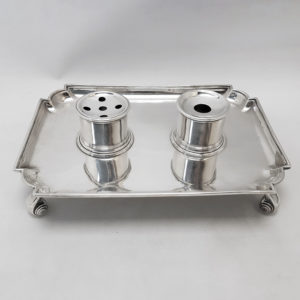
1726
John Edwards II
10243 George I Antique Silver Inkstand
£6,950
A rare early English silver standish of plain rectangular design raised on large scroll feet. Sterling silver. Mounted on top are two circular containers for ink and sand. Excellent weight 999 grams, 32.1 troy ounces. Base height 5 cms, length 28 cms, width 19.5 cms. Ink bottle height, 5 cms, diameter 5.75 cms. London 1726. Maker John Edwards.
-

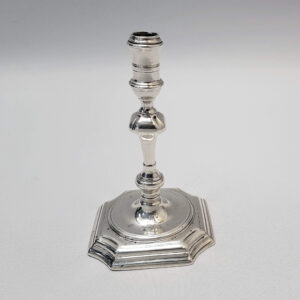
1730
John Bache
10363 George II Antique Silver Taperstick
£1,050
A delightful little antique silver taper stick of plain early design with baluster stem and square octagonal foot with a sunken well. Nice plain style and straight lines. Cast silver. Hand engraved within the well is a “hand” crest. Weight 94g, 3.0 troy oz. Height 10.5cm. Base diameter 6.5cm. London 1730. Maker John Bache. Sterling silver. This taperstick would make a good pair with #10360 (minor differences).
-

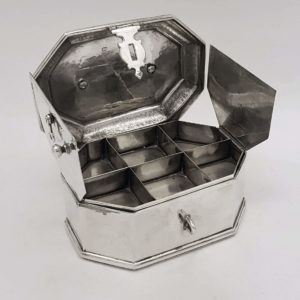
1733
Edward Vincent
9695 George II Silver Box
Sold
A rare antique silver box of hexagonal form with a folding strapwork catch; the hinged lid having a large drop handle supported by ball finials. Of plain form and heavy gauge silver, this unusual box is extremely heavy. The interior pull out tray has two hinged lids enclosing six compartments. Possibly a spice box, although spice boxes of this period usually had a double centrally hinged lid, could also be used for cash or jewellery. Weight 1268 grams, 40.7 troy ounces. Height 9.5cm. Top measures 17 x 12cm. London 1733. Maker Edward Vincent. Sterling silver.
-

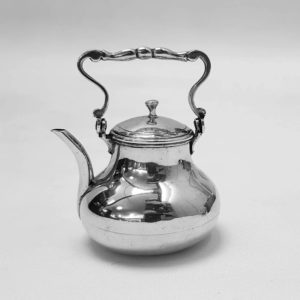
1737
Willem Van Strant
10116 Antique Dutch Silver Miniature Teapot
£1,250
A Dutch silver toy teapot of pear shaped form with swing handle and detachable lid. Very good condition. Excellent patina. Weight 45 grams, 1.5 troy ounces. Height 5.5cm (to top of handle), 4.4cm (to top of knob). Made in Amsterdam, Netherlands. Date mark “C” for 1737. Maker Willem Van Strant.
-

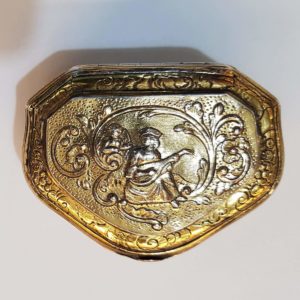
1740
9957 George II Antique Silver Cashew Box
£675
An attractive little antique sterling silver cashew box, or silver snuff box, of heart shaped design. Original gilt finish. The embossed lid decoration shows a young man playing a lute with a putto in the background. Weight 40 grams, 1.2 troy ounces. Height 2.5cm. Top measures 6 x 5cm. London 1740. Maker “LM”. Sterling silver.
-

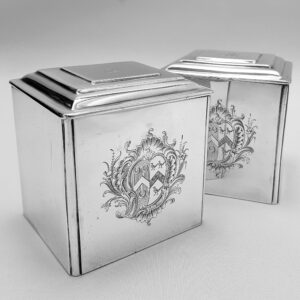
1746
John Swift
10388 George II Pair of Antique Silver Tea Caddies
£5,850
An exceptional pair of rectangular silver tea cannisters with stepped hinged lids and canted corners. The plain form, almost cubic, is very attractive. To the front of each is an expansive hand engraved armorial for Martin within a decorative cartouche, the covers have a crest. Total weight 805g, 25.8 troy oz. Height 9.6cm. Width 9.2cm. Depth 8.4cm. London 1746. Maker John Swift. Sterling silver.
-

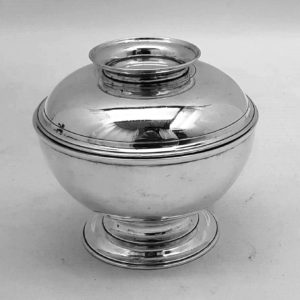
1748
Samuel Taylor
9867 George II Covered Sugar Bowl
Sold
A rare antique sterling silver covered sugar bowl of circular form on a small spreading foot. Excellent plain design, typical of the period. Good colour. In the early 18th century sugar bowls or sugar boxes nearly always had covers which, when reversed, could be used as a saucer or spoon tray. Weight 219 grams, 7.0 troy ounces. Total height 9cm. Bowl diameter 9.7cm. London 1748. Maker probably Samuel Taylor a specialist tea caddy and sugar bowl maker.
-

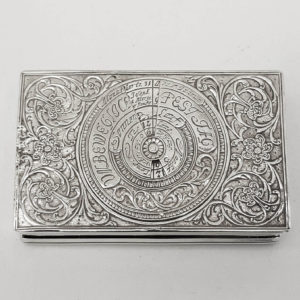
Circa 1750
9674 Antique Silver Perpetual Calendar Snuff Box
Sold
An 18th century silver snuff box with rotating dials to both sides. Very charming and retains the interior gilding. The panels have scrolled flower and chased decoration. The top side has the rotatable “Calendarium Perpetuum” which shows the days of the week (in old German script, and marked with their planetary signs) against days of the month. The reverse side has seven readout windows described by the headings on the rotatable disk (in old German script) – 1) month of the year with its number of days, 2) the important saints’ and feast days in the month, 3) sun’s Zodiacal position (represented by amusing little hand engraved zodiac symbols), 4) length of day, 5) length of night, 6) time of sun rise, and 7) time of sunset. A good example in very good condition. 126 grams, 4 troy ounces. Length 8.4cm. Width 5.5cm. Height 2cm. German. Probably 18th century circa 1750. Unmarked silver.
-

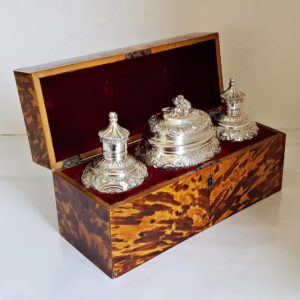
1751
John Jacob
9784 George II Silver Caddies in a Box
£11,750
A stunning quality set of antique silver tea caddies and covered sugar bowl in a later fitted lockable tortoiseshell box with silver mounts. Very heavy gauge, cast silver. The deeply embossed and chased silver decoration is particularly attractive and each piece has a cartouche with a lion crest to the front. The two baluster shaped caddies, for green and black tea, have lift off tops. The bowl has a hinged lid with a bouquet of flowers finial. Total weight of 3 boxes 1,373 grams, 44 troy ounces. Tea caddy height 16.5cm. Sugar bowl height 15.5cm. London 1751. Maker John Jacobs, of Hugeunot origin. The box handle is hallmarked for London 1805, maker “JS”. Sterling silver.
-

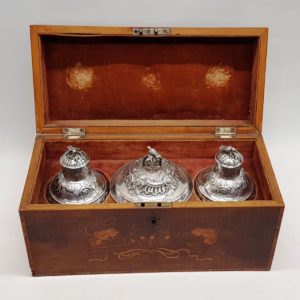
1752
Samuel Herbert And Company
9504 George II Silver Caddies in a Box
£6,750
An excellent quality pair of antique sterling silver tea caddies and matching covered sugar bowl with gilt interior. All with cast silver bird finials and contained in a fitted Sheraton period wooden box with coloured flower and foliage inlays. The deeply embossed and chased silver decoration is particularly attractive and each caddy has a fine hand engraved coat of arms to the front. Heavy weight. The two caddies, for green and black tea, have the original lift off tops now drilled with holes to convert them into sugar shakers (muffinieres). Total weight of 3 boxes 882 grams, 28.3 troy ounces. Sugar casters height 15.5cm. Sugar bowl height 14cm, diameter 10.3cm. London 1752. Maker S Herbert & Co..
-

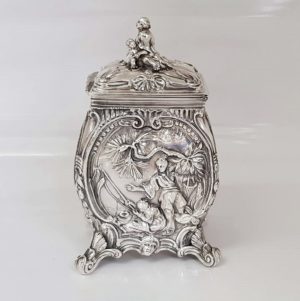
1761
Emick Romer
9755 George III Silver Chinoiserie Tea Caddy
Sold
A fine example of an antique silver caddy box of bombe form with a side hinged lid and standing on scrolling feet. The sides are embossed with charming scenes of Chinese daily life. The lid finial is in the form of a mother and baby. Weight 366 grams, 11.7 troy ounces. Height 16cm. Body measurements at maximum – width 9.2cm, depth 8cm. London 1761. Maker Emick Romer. Sterling silver.